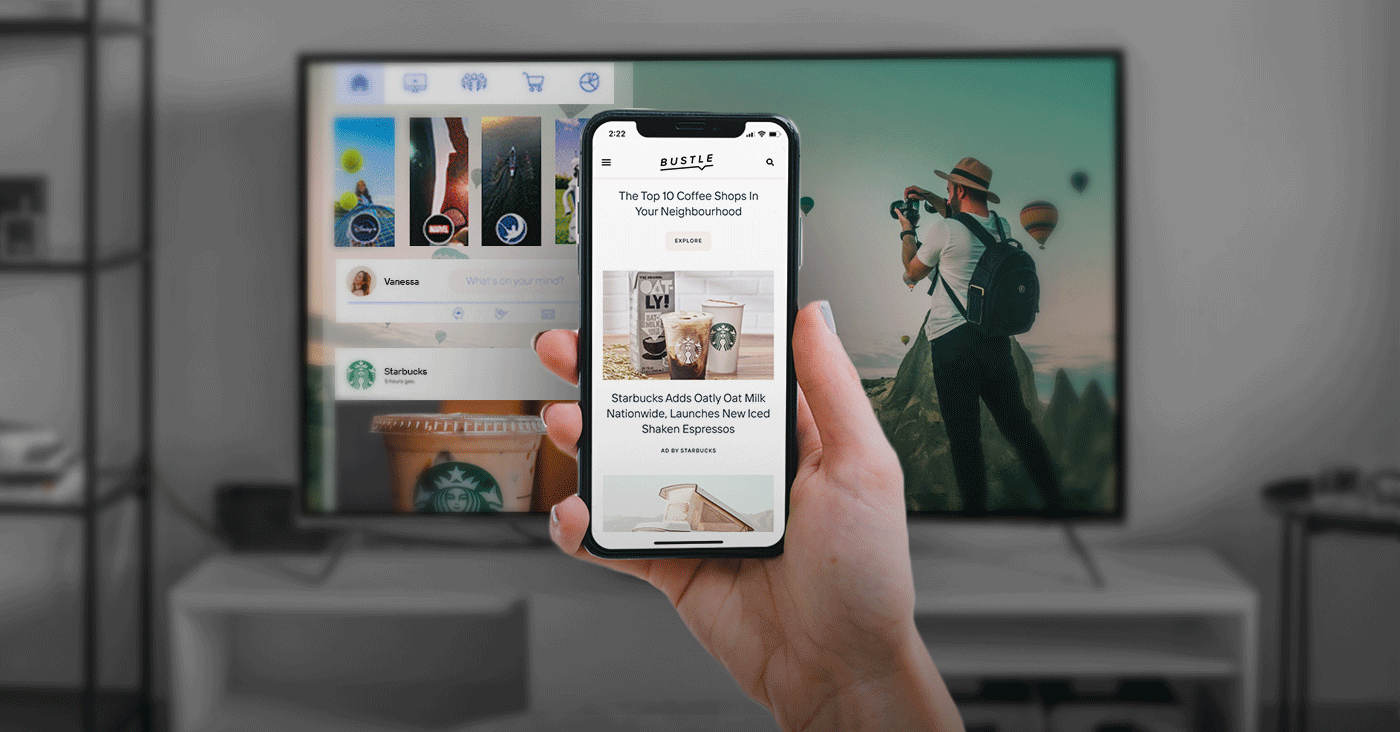Until recently, the newspaper, magazine, TV, computer have been considered “the other,” something separate from our bodies and sense of self. Technology is a tool that’s used, media is something that’s read, and the TV is something that’s watched. Now, with the internet in our pockets, an addictively-personalized feed of stories always at the ready, and every fact and memory in the cloud, something has quietly changed. A phone is no longer “the phone,” it’s “my phone.” A feed is not “the feed,” it’s “my feed.”
But TV is still “the” TV, not “my” TV. Why?
Because the design paradigm for TV has not yet transformed to a feed.
While my phone and feed are personalized, the TV is just a screen on the wall. TV today is analogous to the web of 1999 — individual pages connected through a loosely organized guide (like early AOL), with evergreen content that’s entirely disconnected from my social graph and from my sense of identity and human connection.
Even as a cord-cutter, along with 64% of Millennials, watching TV still feels antiquated and clunky. It’s no wonder that 70% of people now shift their attention between watching TV and scrolling their feeds.
The design of a feed is addictive because it’s always fresh, one thumb-scroll away, and underpinned by a personalized social network. It’s no surprise that content filtered by friends is more interesting than whatever is on the TV Guide — content that’s weaved in between human connections is how culture is born.
And while media has always shaped culture, in today’s world, the media that shapes culture is largely coming from internet-native sources like Instagram, TikTok, Spotify, YouTube — not from television.
The rise of Connected TV will trigger the emergence of the feed
As the new TV ecosystem evolves, the catalyzing change that will render traditional TV irrelevant will be a UX overhaul of how we interact with our TVs.
TV’s UX will shift dramatically — from a point-and-click TV Guide to a feed. A feed of shows, news, photos and Stories intertwined with comments and faces from your social network, all algorithmically-organized to surface whatever is most relevant and engaging.

Channel-surfing will become feed-scrolling.
Watching CNN : watching TikTok.
“Watching Sportscenter” : “following the Nike account.”
Stories will rise to global prominence as a third mega media category, alongside Movies and Shows.
While today, the rare moment of seeing a friend on TV triggers a gleeful “I saw you on TV!!”, in the future, our screens will become full of people we know.
But how will we get from TV Guide to Feed?
We’re beginning to feel the feed creep into our TV screens when apps like TikTok launched exclusively on Amazon’s Fire TV. And the feed will only grow when Instagram launches a killer TV app, and when the TV remote becomes your phone.
In a world where 80% of households already have “smart” TVs, YouTube is the largest connected TV app. But the design is a sad copy of YouTube circa 2008: tiles in a grid. And no social network, no feed.
Imagine a world where Google and Facebook strike a devil’s partnership and bring your Facebook social network to YouTube: that’s feed-based TV.
If an unlikely Google/Facebook partnership is a bridge too far, then imagine a YouTube TV experience underpinned by a social network latently-generated from your Android address book and Gmail contacts. Imagine on top of that social network, an experience that marries content from Disney, with digitally-native content from influencers, with personal content from friends — all in your TV feed.
And just like that, as starkly as the shift from newspapers and magazines to the Facebook feed, watching TV will get turned on its head.
“Stories” will become a 3rd media category equal to “Movies” and “TV”
Today’s TV is driven by a series of 30-60 minute episodes organized around a theme with a multi-episode story arc, made compelling by contrived character development.
Today’s digital media exists as 30-60 second stories, organized around individuals with spontaneous and authentic character development.
As social platforms launch apps onto feed-based TV, “Stories” will elevate to a major media category in parallel to and as large as “Movies” and “TV.”
The phrase “watch TV” will fade away into obscurity
Just as the phrases “grab a newspaper” or “pick up a magazine” have all but disappeared, the phrase “watching TV” will similarly fade into obscurity.
New language will emerge to describe the experience of interacting with feed-based TV, like “what’s in our feed?” or “I saw your Story.”
With a feed comes “feedback”
Like other modern media, likes and comments will emerge as a design pattern in a feed-based TV experience, and feedback from you and your social network will inform the algorithm that drives what your feed shows you on TV.
And will it be monetized with banner ads?
Of course not.
Of the social platforms that now dominate both time on phones and advertising revenue (Facebook, etc), not a single one makes even a dollar on traditional banner advertising. No major platform that has come to prominence in the modern era has chosen anything except native monetization.
Native ads — ads integrated to the user experience — have risen to prominence not because they’re a hack for better engagement and higher monetization, but because they respect the intimacy of the medium and beget sustainable, meaningful attention. Companies can no longer afford to interrupt the personal, private experience of the feed — they must embed themselves within it.
A Postcard from the Future of the “Metaverse!”
In the future we will live in a world where TV is another socially-connected, feed-based screen like a phone or a tablet or a laptop, tied into your actual social network and identity, with hearts, likes and comments, then TV simply becomes just one more entry point into the metaverse. A screen on the wall that opens a portal to your digital world: your friends, your content, and your personally-curated, always-fresh feed.
Until recently, the newspaper, magazine, TV, computer have been considered “the other,” something separate from our bodies and sense of self. Technology is a tool that’s used, media is something that’s read, and the TV is something that’s watched. Now, with the internet in our pockets, an addictively-personalized feed of stories always at the ready, and every fact and memory in the cloud, something has quietly changed. A phone is no longer “the phone,” it’s “my phone.” A feed is not “the feed,” it’s “my feed.”
But TV is still “the” TV, not “my” TV. Why?
Because the design paradigm for TV has not yet transformed to a feed.
While my phone and feed are personalized, the TV is just a screen on the wall. TV today is analogous to the web of 1999 — individual pages connected through a loosely organized guide (like early AOL), with evergreen content that’s entirely disconnected from my social graph and from my sense of identity and human connection.
Even as a cord-cutter, along with 64% of Millennials, watching TV still feels antiquated and clunky. It’s no wonder that 70% of people now shift their attention between watching TV and scrolling their feeds.
The design of a feed is addictive because it’s always fresh, one thumb-scroll away, and underpinned by a personalized social network. It’s no surprise that content filtered by friends is more interesting than whatever is on the TV Guide — content that’s weaved in between human connections is how culture is born.
And while media has always shaped culture, in today’s world, the media that shapes culture is largely coming from internet-native sources like Instagram, TikTok, Spotify, YouTube — not from television.
The rise of Connected TV will trigger the emergence of the feed
As the new TV ecosystem evolves, the catalyzing change that will render traditional TV irrelevant will be a UX overhaul of how we interact with our TVs.
TV’s UX will shift dramatically — from a point-and-click TV Guide to a feed. A feed of shows, news, photos and Stories intertwined with comments and faces from your social network, all algorithmically-organized to surface whatever is most relevant and engaging.

Channel-surfing will become feed-scrolling.
Watching CNN : watching TikTok.
“Watching Sportscenter” : “following the Nike account.”
Stories will rise to global prominence as a third mega media category, alongside Movies and Shows.
While today, the rare moment of seeing a friend on TV triggers a gleeful “I saw you on TV!!”, in the future, our screens will become full of people we know.
But how will we get from TV Guide to Feed?
We’re beginning to feel the feed creep into our TV screens when apps like TikTok launched exclusively on Amazon’s Fire TV. And the feed will only grow when Instagram launches a killer TV app, and when the TV remote becomes your phone.
In a world where 80% of households already have “smart” TVs, YouTube is the largest connected TV app. But the design is a sad copy of YouTube circa 2008: tiles in a grid. And no social network, no feed.
Imagine a world where Google and Facebook strike a devil’s partnership and bring your Facebook social network to YouTube: that’s feed-based TV.
If an unlikely Google/Facebook partnership is a bridge too far, then imagine a YouTube TV experience underpinned by a social network latently-generated from your Android address book and Gmail contacts. Imagine on top of that social network, an experience that marries content from Disney, with digitally-native content from influencers, with personal content from friends — all in your TV feed.
And just like that, as starkly as the shift from newspapers and magazines to the Facebook feed, watching TV will get turned on its head.
“Stories” will become a 3rd media category equal to “Movies” and “TV”
Today’s TV is driven by a series of 30-60 minute episodes organized around a theme with a multi-episode story arc, made compelling by contrived character development.
Today’s digital media exists as 30-60 second stories, organized around individuals with spontaneous and authentic character development.
As social platforms launch apps onto feed-based TV, “Stories” will elevate to a major media category in parallel to and as large as “Movies” and “TV.”
The phrase “watch TV” will fade away into obscurity
Just as the phrases “grab a newspaper” or “pick up a magazine” have all but disappeared, the phrase “watching TV” will similarly fade into obscurity.
New language will emerge to describe the experience of interacting with feed-based TV, like “what’s in our feed?” or “I saw your Story.”
With a feed comes “feedback”
Like other modern media, likes and comments will emerge as a design pattern in a feed-based TV experience, and feedback from you and your social network will inform the algorithm that drives what your feed shows you on TV.
And will it be monetized with banner ads?
Of course not.
Of the social platforms that now dominate both time on phones and advertising revenue (Facebook, etc), not a single one makes even a dollar on traditional banner advertising. No major platform that has come to prominence in the modern era has chosen anything except native monetization.
Native ads — ads integrated to the user experience — have risen to prominence not because they’re a hack for better engagement and higher monetization, but because they respect the intimacy of the medium and beget sustainable, meaningful attention. Companies can no longer afford to interrupt the personal, private experience of the feed — they must embed themselves within it.
A Postcard from the Future of the “Metaverse!”
In the future we will live in a world where TV is another socially-connected, feed-based screen like a phone or a tablet or a laptop, tied into your actual social network and identity, with hearts, likes and comments, then TV simply becomes just one more entry point into the metaverse. A screen on the wall that opens a portal to your digital world: your friends, your content, and your personally-curated, always-fresh feed.
Behind Headlines: 180 Seconds in Ad Tech is a short 3-minute podcast exploring the news in the digital advertising industry. Ad tech is a fast-growing industry with many updates happening daily. As it can be hard for most to keep up with the latest news, the Sharethrough team wanted to create an audio series compiling notable mentions each week.
Until recently, the newspaper, magazine, TV, computer have been considered “the other,” something separate from our bodies and sense of self. Technology is a tool that’s used, media is something that’s read, and the TV is something that’s watched. Now, with the internet in our pockets, an addictively-personalized feed of stories always at the ready, and every fact and memory in the cloud, something has quietly changed. A phone is no longer “the phone,” it’s “my phone.” A feed is not “the feed,” it’s “my feed.”
But TV is still “the” TV, not “my” TV. Why?
Because the design paradigm for TV has not yet transformed to a feed.
While my phone and feed are personalized, the TV is just a screen on the wall. TV today is analogous to the web of 1999 — individual pages connected through a loosely organized guide (like early AOL), with evergreen content that’s entirely disconnected from my social graph and from my sense of identity and human connection.
Even as a cord-cutter, along with 64% of Millennials, watching TV still feels antiquated and clunky. It’s no wonder that 70% of people now shift their attention between watching TV and scrolling their feeds.
The design of a feed is addictive because it’s always fresh, one thumb-scroll away, and underpinned by a personalized social network. It’s no surprise that content filtered by friends is more interesting than whatever is on the TV Guide — content that’s weaved in between human connections is how culture is born.
And while media has always shaped culture, in today’s world, the media that shapes culture is largely coming from internet-native sources like Instagram, TikTok, Spotify, YouTube — not from television.
The rise of Connected TV will trigger the emergence of the feed
As the new TV ecosystem evolves, the catalyzing change that will render traditional TV irrelevant will be a UX overhaul of how we interact with our TVs.
TV’s UX will shift dramatically — from a point-and-click TV Guide to a feed. A feed of shows, news, photos and Stories intertwined with comments and faces from your social network, all algorithmically-organized to surface whatever is most relevant and engaging.

Channel-surfing will become feed-scrolling.
Watching CNN : watching TikTok.
“Watching Sportscenter” : “following the Nike account.”
Stories will rise to global prominence as a third mega media category, alongside Movies and Shows.
While today, the rare moment of seeing a friend on TV triggers a gleeful “I saw you on TV!!”, in the future, our screens will become full of people we know.
But how will we get from TV Guide to Feed?
We’re beginning to feel the feed creep into our TV screens when apps like TikTok launched exclusively on Amazon’s Fire TV. And the feed will only grow when Instagram launches a killer TV app, and when the TV remote becomes your phone.
In a world where 80% of households already have “smart” TVs, YouTube is the largest connected TV app. But the design is a sad copy of YouTube circa 2008: tiles in a grid. And no social network, no feed.
Imagine a world where Google and Facebook strike a devil’s partnership and bring your Facebook social network to YouTube: that’s feed-based TV.
If an unlikely Google/Facebook partnership is a bridge too far, then imagine a YouTube TV experience underpinned by a social network latently-generated from your Android address book and Gmail contacts. Imagine on top of that social network, an experience that marries content from Disney, with digitally-native content from influencers, with personal content from friends — all in your TV feed.
And just like that, as starkly as the shift from newspapers and magazines to the Facebook feed, watching TV will get turned on its head.
“Stories” will become a 3rd media category equal to “Movies” and “TV”
Today’s TV is driven by a series of 30-60 minute episodes organized around a theme with a multi-episode story arc, made compelling by contrived character development.
Today’s digital media exists as 30-60 second stories, organized around individuals with spontaneous and authentic character development.
As social platforms launch apps onto feed-based TV, “Stories” will elevate to a major media category in parallel to and as large as “Movies” and “TV.”
The phrase “watch TV” will fade away into obscurity
Just as the phrases “grab a newspaper” or “pick up a magazine” have all but disappeared, the phrase “watching TV” will similarly fade into obscurity.
New language will emerge to describe the experience of interacting with feed-based TV, like “what’s in our feed?” or “I saw your Story.”
With a feed comes “feedback”
Like other modern media, likes and comments will emerge as a design pattern in a feed-based TV experience, and feedback from you and your social network will inform the algorithm that drives what your feed shows you on TV.
And will it be monetized with banner ads?
Of course not.
Of the social platforms that now dominate both time on phones and advertising revenue (Facebook, etc), not a single one makes even a dollar on traditional banner advertising. No major platform that has come to prominence in the modern era has chosen anything except native monetization.
Native ads — ads integrated to the user experience — have risen to prominence not because they’re a hack for better engagement and higher monetization, but because they respect the intimacy of the medium and beget sustainable, meaningful attention. Companies can no longer afford to interrupt the personal, private experience of the feed — they must embed themselves within it.
A Postcard from the Future of the “Metaverse!”
In the future we will live in a world where TV is another socially-connected, feed-based screen like a phone or a tablet or a laptop, tied into your actual social network and identity, with hearts, likes and comments, then TV simply becomes just one more entry point into the metaverse. A screen on the wall that opens a portal to your digital world: your friends, your content, and your personally-curated, always-fresh feed.
Founded in 2015, Calibrate is a yearly conference for new engineering managers hosted by seasoned engineering managers. The experience level of the speakers ranges from newcomers all the way through senior engineering leaders with over twenty years of experience in the field. Each speaker is greatly concerned about the craft of engineering management. Organized and hosted by Sharethrough, it was conducted yearly in September, from 2015-2019 in San Francisco, California.
Stay Up-to-Date—
Subscribe to our newsletter and receive cutting-edge digital advertising insights, including our weekly Behind Headlines episodes, delivered right to your inbox.







.png)
